Seyed Amir Hossein Aqajari
Department of Computer Science, University of California, Irvine
ECG Unveiled: Analysis of Client Re-identification Risks in Real-World ECG Datasets
Aug 02, 2024



Abstract:While ECG data is crucial for diagnosing and monitoring heart conditions, it also contains unique biometric information that poses significant privacy risks. Existing ECG re-identification studies rely on exhaustive analysis of numerous deep learning features, confining to ad-hoc explainability towards clinicians decision making. In this work, we delve into explainability of ECG re-identification risks using transparent machine learning models. We use SHapley Additive exPlanations (SHAP) analysis to identify and explain the key features contributing to re-identification risks. We conduct an empirical analysis of identity re-identification risks using ECG data from five diverse real-world datasets, encompassing 223 participants. By employing transparent machine learning models, we reveal the diversity among different ECG features in contributing towards re-identification of individuals with an accuracy of 0.76 for gender, 0.67 for age group, and 0.82 for participant ID re-identification. Our approach provides valuable insights for clinical experts and guides the development of effective privacy-preserving mechanisms. Further, our findings emphasize the necessity for robust privacy measures in real-world health applications and offer detailed, actionable insights for enhancing data anonymization techniques.
Enhancing Performance and User Engagement in Everyday Stress Monitoring: A Context-Aware Active Reinforcement Learning Approach
Jul 11, 2024



Abstract:In today's fast-paced world, accurately monitoring stress levels is crucial. Sensor-based stress monitoring systems often need large datasets for training effective models. However, individual-specific models are necessary for personalized and interactive scenarios. Traditional methods like Ecological Momentary Assessments (EMAs) assess stress but struggle with efficient data collection without burdening users. The challenge is to timely send EMAs, especially during stress, balancing monitoring efficiency and user convenience. This paper introduces a novel context-aware active reinforcement learning (RL) algorithm for enhanced stress detection using Photoplethysmography (PPG) data from smartwatches and contextual data from smartphones. Our approach dynamically selects optimal times for deploying EMAs, utilizing the user's immediate context to maximize label accuracy and minimize intrusiveness. Initially, the study was executed in an offline environment to refine the label collection process, aiming to increase accuracy while reducing user burden. Later, we integrated a real-time label collection mechanism, transitioning to an online methodology. This shift resulted in an 11% improvement in stress detection efficiency. Incorporating contextual data improved model accuracy by 4%. Personalization studies indicated a 10% enhancement in AUC-ROC scores, demonstrating better stress level differentiation. This research marks a significant move towards personalized, context-driven real-time stress monitoring methods.
Controlling the Latent Space of GANs through Reinforcement Learning: A Case Study on Task-based Image-to-Image Translation
Jul 26, 2023
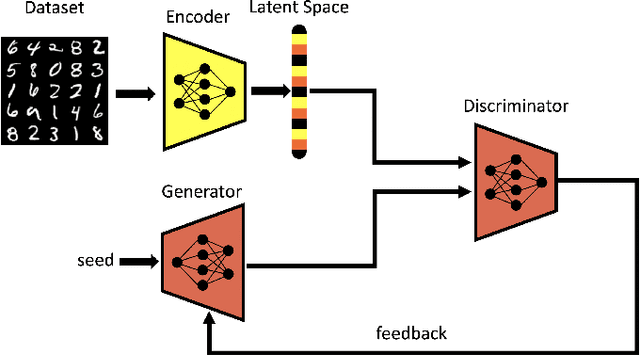
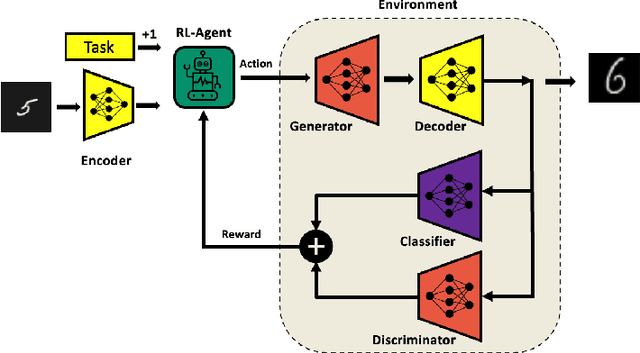
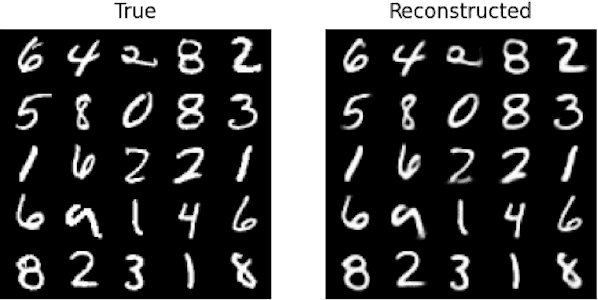
Abstract:Generative Adversarial Networks (GAN) have emerged as a formidable AI tool to generate realistic outputs based on training datasets. However, the challenge of exerting control over the generation process of GANs remains a significant hurdle. In this paper, we propose a novel methodology to address this issue by integrating a reinforcement learning (RL) agent with a latent-space GAN (l-GAN), thereby facilitating the generation of desired outputs. More specifically, we have developed an actor-critic RL agent with a meticulously designed reward policy, enabling it to acquire proficiency in navigating the latent space of the l-GAN and generating outputs based on specified tasks. To substantiate the efficacy of our approach, we have conducted a series of experiments employing the MNIST dataset, including arithmetic addition as an illustrative task. The outcomes of these experiments serve to validate our methodology. Our pioneering integration of an RL agent with a GAN model represents a novel advancement, holding great potential for enhancing generative networks in the future.
Novel Blood Pressure Waveform Reconstruction from Photoplethysmography using Cycle Generative Adversarial Networks
Jan 24, 2022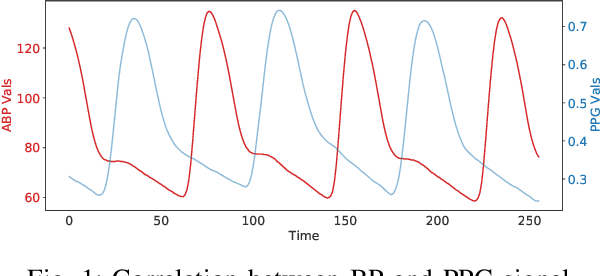
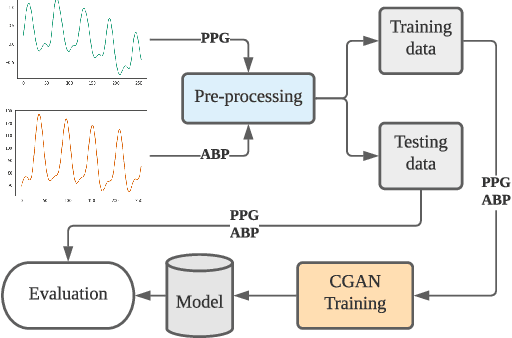
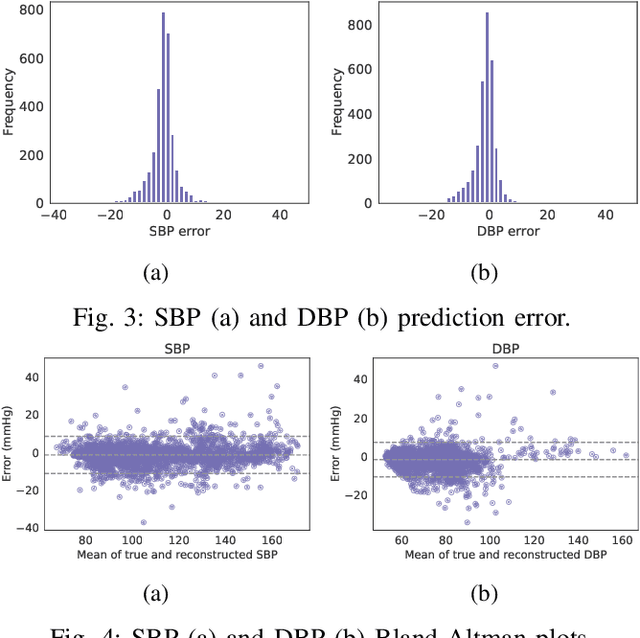
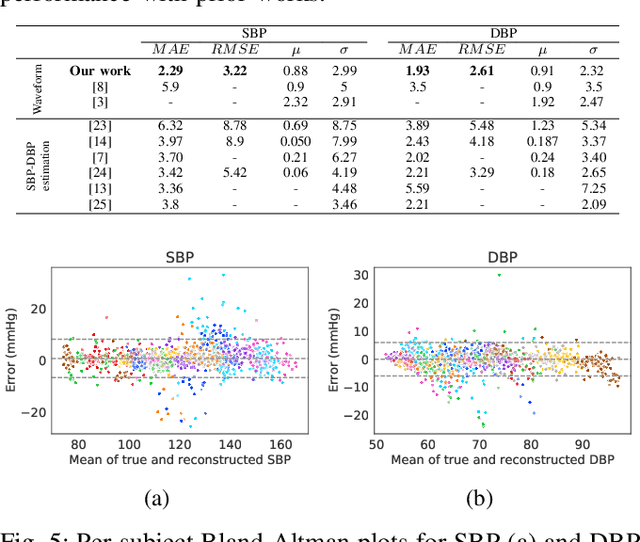
Abstract:Continuous monitoring of blood pressure (BP)can help individuals manage their chronic diseases such as hypertension, requiring non-invasive measurement methods in free-living conditions. Recent approaches fuse Photoplethysmograph (PPG) and electrocardiographic (ECG) signals using different machine and deep learning approaches to non-invasively estimate BP; however, they fail to reconstruct the complete signal, leading to less accurate models. In this paper, we propose a cycle generative adversarial network (CycleGAN) based approach to extract a BP signal known as ambulatory blood pressure (ABP) from a clean PPG signal. Our approach uses a cycle generative adversarial network that extends theGAN architecture for domain translation, and outperforms state-of-the-art approaches by up to 2x in BP estimation.
An Accurate Non-accelerometer-based PPG Motion Artifact Removal Technique using CycleGAN
Jun 22, 2021



Abstract:A photoplethysmography (PPG) is an uncomplicated and inexpensive optical technique widely used in the healthcare domain to extract valuable health-related information, e.g., heart rate variability, blood pressure, and respiration rate. PPG signals can easily be collected continuously and remotely using portable wearable devices. However, these measuring devices are vulnerable to motion artifacts caused by daily life activities. The most common ways to eliminate motion artifacts use extra accelerometer sensors, which suffer from two limitations: i) high power consumption and ii) the need to integrate an accelerometer sensor in a wearable device (which is not required in certain wearables). This paper proposes a low-power non-accelerometer-based PPG motion artifacts removal method outperforming the accuracy of the existing methods. We use Cycle Generative Adversarial Network to reconstruct clean PPG signals from noisy PPG signals. Our novel machine-learning-based technique achieves 9.5 times improvement in motion artifact removal compared to the state-of-the-art without using extra sensors such as an accelerometer.
An End-to-End and Accurate PPG-based Respiratory Rate Estimation Approach Using Cycle Generative Adversarial Networks
May 03, 2021


Abstract:Respiratory rate (RR) is a clinical sign representing ventilation. An abnormal change in RR is often the first sign of health deterioration as the body attempts to maintain oxygen delivery to its tissues. There has been a growing interest in remotely monitoring of RR in everyday settings which has made photoplethysmography (PPG) monitoring wearable devices an attractive choice. PPG signals are useful sources for RR extraction due to the presence of respiration-induced modulations in them. The existing PPG-based RR estimation methods mainly rely on hand-crafted rules and manual parameters tuning. An end-to-end deep learning approach was recently proposed, however, despite its automatic nature, the performance of this method is not ideal using the real world data. In this paper, we present an end-to-end and accurate pipeline for RR estimation using Cycle Generative Adversarial Networks (CycleGAN) to reconstruct respiratory signals from raw PPG signals. Our results demonstrate a higher RR estimation accuracy of up to 2$\times$ (mean absolute error of 1.9$\pm$0.3 using five fold cross validation) compared to the state-of-th-art using a identical publicly available dataset. Our results suggest that CycleGAN can be a valuable method for RR estimation from raw PPG signals.
Detection of COVID-19 Using Heart Rate and Blood Pressure: Lessons Learned from Patients with ARDS
Nov 12, 2020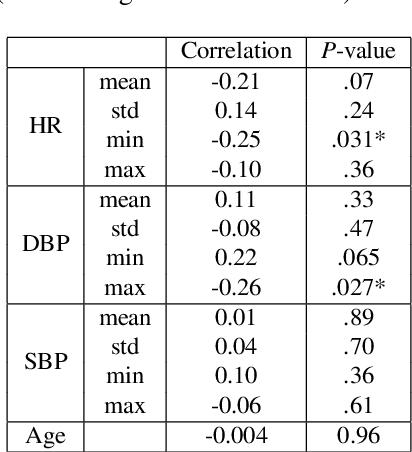
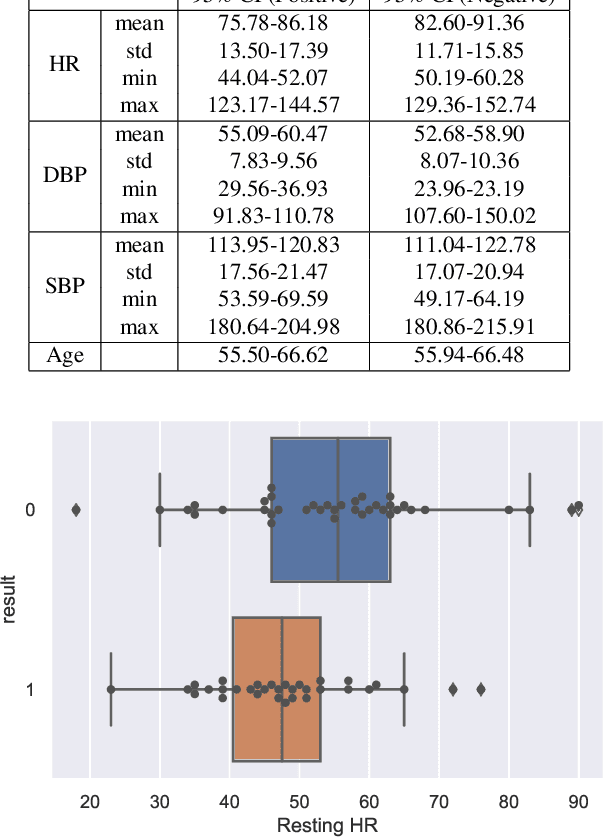
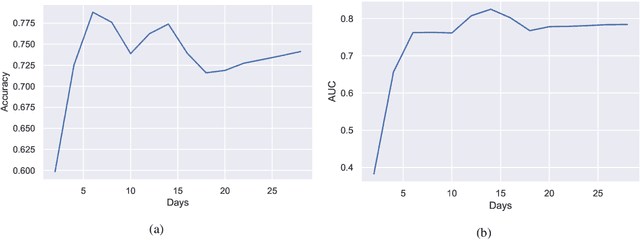
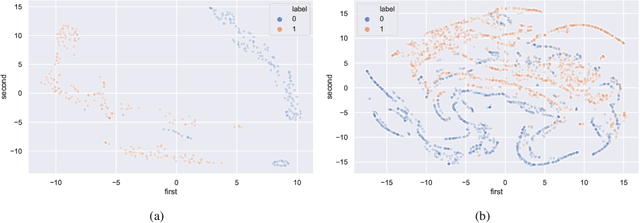
Abstract:The world has been affected by COVID-19 coronavirus. At the time of this study, the number of infected people in the United States is the highest globally (7.9 million infections). Within the infected population, patients diagnosed with acute respiratory distress syndrome (ARDS) are in more life-threatening circumstances, resulting in severe respiratory system failure. Various studies have investigated the infections to COVID-19 and ARDS by monitoring laboratory metrics and symptoms. Unfortunately, these methods are merely limited to clinical settings, and symptom-based methods are shown to be ineffective. In contrast, vital signs (e.g., heart rate) have been utilized to early-detect different respiratory diseases in ubiquitous health monitoring. We posit that such biomarkers are informative in identifying ARDS patients infected with COVID-19. In this study, we investigate the behavior of COVID-19 on ARDS patients by utilizing simple vital signs. We analyze the long-term daily logs of blood pressure and heart rate associated with 70 ARDS patients admitted to five University of California academic health centers (containing 42506 samples for each vital sign) to distinguish subjects with COVID-19 positive and negative test results. In addition to the statistical analysis, we develop a deep neural network model to extract features from the longitudinal data. Using only the first eight days of the data, our deep learning model is able to achieve 78.79% accuracy to classify the vital signs of ARDS patients infected with COVID-19 versus other ARDS diagnosed patients.
GSR Analysis for Stress: Development and Validation of an Open Source Tool for Noisy Naturalistic GSR Data
May 09, 2020
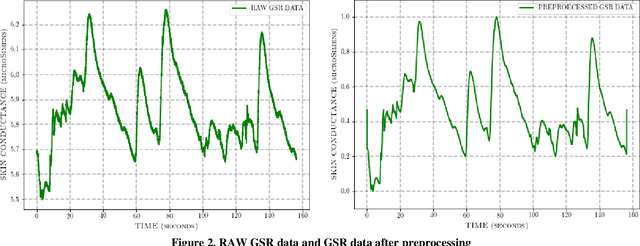
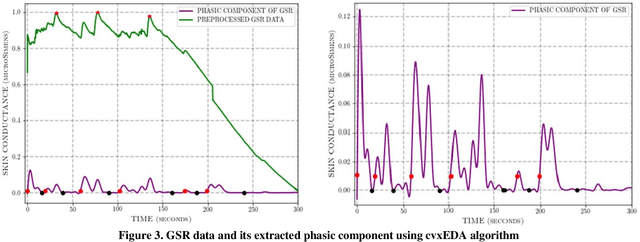
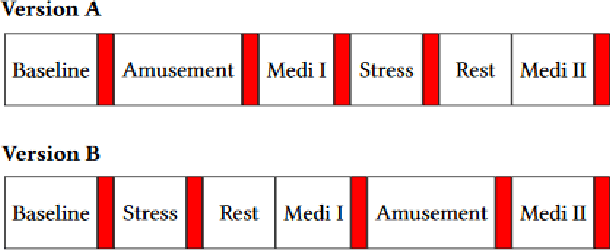
Abstract:The stress detection problem is receiving great attention in related research communities. This is due to its essential part in behavioral studies for many serious health problems and physical illnesses. There are different methods and algorithms for stress detection using different physiological signals. Previous studies have already shown that Galvanic Skin Response (GSR), also known as Electrodermal Activity (EDA), is one of the leading indicators for stress. However, the GSR signal itself is not trivial to analyze. Different features are extracted from GSR signals to detect stress in people like the number of peaks, max peak amplitude, etc. In this paper, we are proposing an open-source tool for GSR analysis, which uses deep learning algorithms alongside statistical algorithms to extract GSR features for stress detection. Then we use different machine learning algorithms and Wearable Stress and Affect Detection (WESAD) dataset to evaluate our results. The results show that we are capable of detecting stress with the accuracy of 92 percent using 10-fold cross-validation and using the features extracted from our tool.
 Add to Chrome
Add to Chrome Add to Firefox
Add to Firefox Add to Edge
Add to Edge